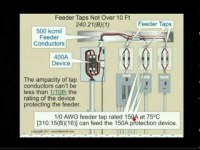Greetings everyone, I have another PV scenario
This one is a existing building that has a 120/240 200A main and 4/0 AL going to a gutter.
Then there are 4 fused 60A disconnects tapped off the gutter and a 100A panel tapped at the end.
The first fused disconnect is empty and would be an ideal place to pipe the inverter to.
However the sum of the OCPD's on the feeder is 220A, but no OCPD is "greater than" the 4/0 AL ampacity.
Does this comply with 705.12(B)(1)(b)?

This one is a existing building that has a 120/240 200A main and 4/0 AL going to a gutter.
Then there are 4 fused 60A disconnects tapped off the gutter and a 100A panel tapped at the end.
The first fused disconnect is empty and would be an ideal place to pipe the inverter to.
However the sum of the OCPD's on the feeder is 220A, but no OCPD is "greater than" the 4/0 AL ampacity.
Does this comply with 705.12(B)(1)(b)?




